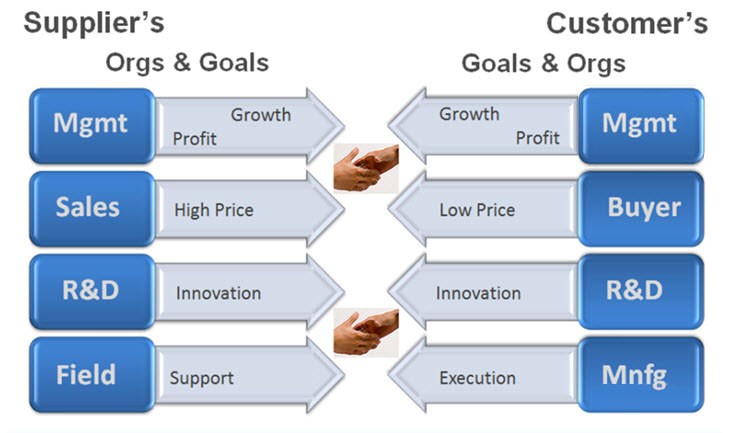The difference between partnering and purchasing is that partnering can only happen when both parties see their future as mutually interdependent. In contrast, purchasing can occur anytime the seller has a product and the buyer has money. Therefore, the level of partnership can be measured by the times each makes a commitment to the other with no immediate reward. This is the easy part.

B2B relationships are fundamentally complex due to the levels of interaction that must occur for partnering to be real. The biggest point of conflict between supplier and customer occur where interfacing organizations have conflicting goals. The classic is between sales, who want the highest price, and buyers, who want the lowest price. This gets compounded when managements are more aligned with their profit than their growth goals. On the customer’s side, conflict typically arises in the organizational cracks between buyers, R&D, and manufacturing, where time and the cost of getting the lowest price does not align with R&D’s need for innovation on a short time-to-market constraint and manufacturing’s need for execution.
So companies can only be successful in partnering when managements keep their organizations focused on optimizing to overall growth goals over sub-optimizing to individual organization goals. This is why PICOS trades short-term cost savings for long-term failure. It elevates low price to the highest goal. In order to do that, it must be mistrustful, while closing communication channels between operational parts of the customer and the supplier. Hence, it closes off the benefit of partnership in favor of transactions, for which the benefits are easier to measure. It is a mentality of, ‘In the long term, we’ll be working somewhere else.’
The partnership that formed between Intel and Nikon in the eighties is a great example of this. For Intel, the growth strategy was to pivot from memory to microprocessors. With microprocessors, speed and power performance is tightly linked to CD control. Nikon’s steppers had the best lenses in the world, but even these were not good enough for Intel. Nikon wasn’t sure why, but they decided to move forward on the basis of trust. Nikon let Intel into their factories and allowed them very close control over element selection and lens assembly. The result was critical in Intel’s rise to leadership of the semiconductor industry. For Nikon, the benefit was tight access to a soon to soar customer at time when its own customer base in Japan would falter. This partnership is why Nikon is one of only two advance exposure tool manufacturers to survive from the original13 that then existed.
By G Dan Hutcheson Copyright © VLSI Research Inc. All rights reserved.